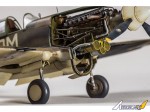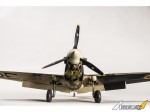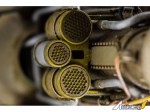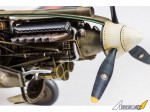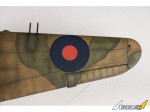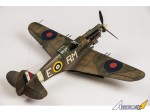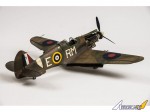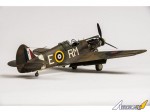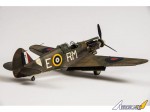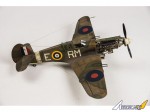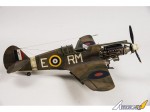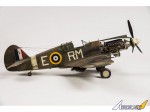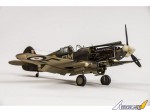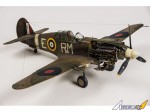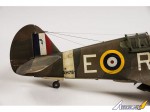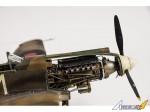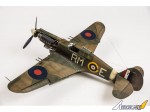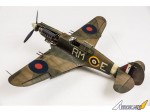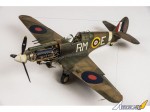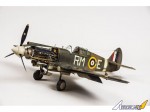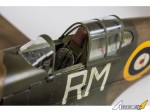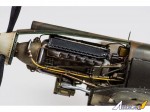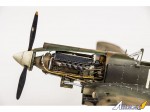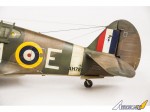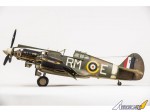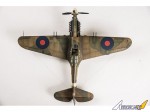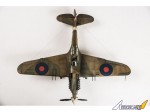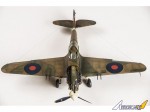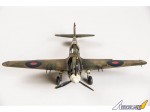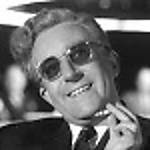1⁄32Curtiss Tomahawk
8
Comments
History
The Curtiss P-40 Warhawk is an American single-engined, single-seat, all-metal fighter and ground-attack aircraft that first flew in 1938. The P-40 design was a modification of the previous Curtiss P-36 Hawk which reduced development time and enabled a rapid entry into production and operational service. The Warhawk was used by most Allied powers during World War II, and remained in frontline service until the end of the war. It was the third most-produced American fighter, after the P-51 and P-47; by November 1944, when production of the P-40 ceased, 13,738 had been built, all at Curtiss-Wright Corporation's main production facilities at Buffalo, New York.P-40 Warhawk was the name the United States Army Air Corps and after June 1941, USAAF-adopted name for all models, making it the official name in the U.S. for all P-40s. The British Commonwealth and Soviet air forces used the name Tomahawk for models equivalent to the P-40B and P-40C, and the name Kittyhawk for models equivalent to the P-40D and all later variants.
P-40s first saw combat with the British Commonwealth squadrons of the Desert Air Force in the Middle East and North African campaigns, during June 1941. No. 112 Squadron Royal Air Force, was among the first to operate Tomahawks in North Africa and the unit was the first Allied military aviation unit to feature the "shark mouth" logo, copying similar markings on some Luftwaffe Messerschmitt Bf 110 twin-engine fighters.
The P-40's lack of a two-speed supercharger made it inferior to Luftwaffe fighters such as the Messerschmitt Bf 109 or the Focke-Wulf Fw 190 in high-altitude combat and it was rarely used in operations in Northwest Europe. However, between 1941 and 1944, the P-40 played a critical role with Allied air forces in three major theaters: North Africa, the Southwest Pacific, and China. It also had a significant role in the Middle East, Southeast Asia, Eastern Europe, Alaska and Italy. The P-40's performance at high altitudes was not as important in those theaters, where it served as an air superiority fighter, bomber escort and fighter-bomber. Although it gained a postwar reputation as a mediocre design, suitable only for close air support, recent research including scrutiny of the records of individual Allied squadrons indicates that this was not the case: the P-40 performed surprisingly well as an air superiority fighter, at times suffering severe losses but also taking a very heavy toll of enemy aircraft. The P-40 offered the additional advantage of low cost, which kept it in production as a ground-attack aircraft long after it was obsolete as a fighter. History adapted from Wikipedia.
The Model
The kit Trumpeter in 1/32 scale (code 02 228) represents the version that was active in northern Europe and contains great detail.Construction
Once equipped with the No. 32553 P 40 interior set, JX 044 express masks of Eduard and RB 1/32 M2 Browning set we started our manufacture of the cockpit area. The detail provided in the kit in conjunction with the minimum of intervention and Eduard set, giving us a very plausible results. We continued with the engine Allison V-1710 which is in our opinion the best in kit form .With the help of photos and internet and the real, added that he needed to get to the construction of a replica. The amazing kit oil cooler further improved with photoetched screens giving the company and adding metal brass struts. From plastics manufacturers along the belt, where more of the supported air brakes of airplane. Opened two ammunition boxes of the left wing, landing legs have been improved with the addition wiring, while the three antennas of the single-channel RF radio system (VHF + UHF) which they brought the Tomahawk, manufactured from thin fishing line.Painting and finishing
The camouflage of the upper surfaces stained with Lifecolor colors, with the following codes: UA 091 Dark Green and UA 016 Dark Earth. For the lower surfaces used the UA 021 Light Grey and X-1 Black of Tamiya. Wanting to add a third dimension to the two-tone variant we left preshading prior to seems a little more intense at the top of the wings. The interior of the cockpit was painted with H 58 Interior Green of Gunze, the seat of the pilot to the ALC 106 White Aluminium of Alclad. The signals flawlessly applied and sealed with XF 86 Flat Clear of Tamiya. End was wash with raw umber of Winsor Newton and dusted with hagiography shade coffee powders.I hope you like it!
Comments
Christos,
Just an extraordinary build of the Trumpeter 1/32 P-40B Tomahawk. Your engine really has brought this older kit up to today's Tamiya's standards. As for your upgrading the cockpit interior, I would have really loved to see detailed pictures of exactly what it looks like especially after you've done your exceptional detailing, painting, and weathering.
Joel
AUG 21, 2016 - 09:30 PM
Christos,
What a splendid build! The engine details make it stunning!
Gaz
AUG 22, 2016 - 04:28 AM
Talk about making a silk purse out of a sows ear!! I don't like this kit for a lot of reasons but you have managed to make it into a masterful build. Great job and thank you for sharing. Take care. Jim
AUG 24, 2016 - 02:16 AM
Thank you Joel,Gary and Jim for the nice comments!I want to tell you that for many years I have been seen your beautiful builds like a visitor in the Aeroscale.Best wishes!Thank you again.
AUG 29, 2016 - 06:25 PM
Hi Christos, I'm glad to see you got your membership sorted out. Welcome to Aeroscale! Don't forget to visit your other articles here, here and here.
AUG 30, 2016 - 09:26 AM
Thank you for the things you have done for me and for your comments.I'm glad too for being a member of this side with the greatests modelers!
AUG 30, 2016 - 05:58 PM
Christos, extraordinary work with the best looking of the P-40 airframes! Your model is top-notch. I have the old Meteor P-40 cockpit so I am inspired to start mine. Thanks for this model.
SEP 05, 2016 - 09:31 PM
Thank you very much Frederick for your good words.I will be waiting your build with suspense!Thanks again.
SEP 05, 2016 - 11:08 PM
Copyright ©2021 by christos papadopoulos. Images also by copyright holder unless otherwise noted. The views and opinions expressed herein are solely the views and opinions of the authors and/or contributors to this Web site and do not necessarily represent the views and/or opinions of AeroScale, KitMaker Network, or Silver Star Enterrpises. Images also by copyright holder unless otherwise noted. Opinions expressed are those of the author(s) and not necessarily those of AeroScale. All rights reserved. Originally published on: 2016-08-21 09:25:14. Unique Reads: 9355





